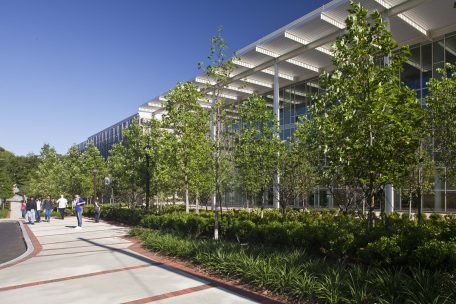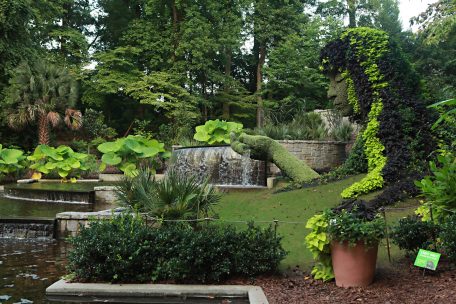Performance Landscapes
Performance Landscapes – Putting Sustainability to Work in Resort Design

Walter Jamieson, PhD, a professor of tourism and travel industry management at the University of Hawaii at Manoa, has studied sustainable tourism for 20 years and written guidelines for the UN. “Increasingly there are groups of tourists who, everything else being equal, are going to look at environmental or social responsibility,” says Jamieson. “Destinations need to reflect local community values and traditions”. “Tourists want to wake up in the morning and say ‘I’m in a distinctive hotel with a sense of place…”
Globalization is adding to pressure on the tourism market. Peter McElhinney, Chief Operating Officer of Lagomar Properties, notes that competition for the same tourist dollar is no longer constrained to a few areas. “In building our hotel we recognize the need to compete with the entire Caribbean basin,” he says. “It is not enough to be best in the neighborhood. You have to the most compelling destination in a swath of geography defined loosely by flight time.” At the same time, McElhinney points to complexity in the needs and expectations of the guests: “You have to understand the contradictory impulses of people—they like to return to the familiar places and at the same time seek out novelty.”
What do these trends mean for the industry? How can resorts satisfy these oppositional desires—for escapism and locality, indulgence and conservation, innovation and history?
The challenge is to create destinations integrally tied to place; settings that amplify regional character and provide a unique experience—all without overstressing local communities and ecosystems. Landscape design offers a primary avenue for addressing this complex set of issues.
What is a performance landscape?
Landscape is the bridge connecting building to place. It grounds design in context and sets the tone for how guests perceive and relate to their immediate and surrounding environment. But this framework doesn’t have to be passive. In fact, in its natural state, landscape is anything but passive. Behind the scene, the landscape has tremendous capacity to perform vital functions, from supporting natural water processes and enhancing native habitats, to harnessing energy and modulating climate impacts, to promoting endemic flora and showcasing ancestral traditions. Thoughtful adoption of performance landscaping can support operational needs while fostering a unique and authentic guest experience.
A performance landscape reaches beyond esthetic appearance. It is design that seeks to unify the seen with the unseen, where landscape elements serve to enhance sustainable functioning resort operations.
In a conventional landscape approach, it’s common to use parallel systems to support an artificial esthetic. Consider exotic plant collections and display fountains that aren’t tied to insect and herbaceous plant control, or thematic gardens without a natural capacity for storm water drainage. When redundant systems are required to provide what could be less invasive or performed via a natural process, opportunities are lost, which could improve efficiencies and lower costs.

In a performance landscape, design elements take on multiple roles. What might appear as esthetic beauty can also be a system to collect and treat rainfall or provide a food source for indigenous fauna. A tranquil design feature can invite guests to relax, while simultaneously supporting threatened flora and repairing invasive species intrusion. Thoughtful landscape design can control erosion, minimize resource use, and provide interpretive and educational opportunities to intuitively communicate environmental awareness and appreciation.
Deborah Marton, executive director of Design Trust for Public Space, a group dedicated to improving New York City’s parks, plazas, streets, and public buildings, says the general ethos of “reduce, reuse, recycle and protect” characterizes performance landscape design. “The goal of high performance design is to reduce consumption of natural or other materials,” says Marton, a lawyer and landscape architect. “To reuse whatever you can or recycle elements onsite. But also to serve and protect existing resources onsite.” But there’s a second layer to performance landscaping, according to Marton: communication. “When you look at a high performance landscape, ideally you can read what’s happening, so the values that are integral to way the landscape was designed are readable to the user. For example, if instead of putting storm water in a sewer pipe and sending it downstream, we can run it into a wetland and make that process readable; then users begin to understand the values that led to the design of particular landscape. The message of a high performance landscape can be spread—it serves an educational purpose.”
A holistic approach
Marton describes environmental benefits of performance landscaping covering conservation and filtration of water, improved air quality, reduction of energy and resource use, reduction of heat island effect and preservation of soil health.
But what are the design sacrifices of a performance landscape? In a resort context a landscape must ultimately serve the guest experience. There can’t be a negative tradeoff in design quality. In fact, by virtue of the comprehensive approach required to balance and reflect the range of aesthetic, environmental, cultural and other essential factors, a performance design is inherently connected and evocative of location in a way that can’t be approximated in a traditional approach. To do so, however, requires awareness and commitment throughout the process: Performance can’t be an afterthought.
At DTJ DESIGN, performance landscape is addressed through interdisciplinary teams working together from the earliest stages. A project team might include landscape architects, planners and architects working closely with ecologists, water experts, geographical information system (GIS) specialists, economists, archeologists, and sociologists. The goal is for planning and design to become part of a long-term and sustainable solution, maturing into thriving places and communities.
At the root of this philosophy is a focus on place. Holistic design that is rooted in location offers the best potential for creating settings with deep connection and meaning. But the quality of aesthetic design standard has to be high, where design is not sacrificed.
Cultural authenticity: Hualalai Resort
Done right, a performance landscape is sensitive to cultural authenticity that tells a unique story of place. Visitors are often drawn to a location for the weather and geographic beauty. The landscape should help them discover the culture of the surrounding context to promote an understanding and appreciation for the heritage of the culture and time tested lessons of its people. The landscape should uphold the elements of place which are in balance and reveal threads of the story through the resort plan and design.
Authenticity is increasingly a strong motivation. “Too often in the past we haven’t been as sensitive to reflecting local values as we could be,” says Professor Jamieson. “What we’ve seen largely, and it’s exemplified here in Hawaii but other place as well, is a pastiche approach, where we stick something on the wall, as opposed to saying ‘How would we design a resort that would truly reflect the surrounding community?’”
The Hualalai Development Company, developers of Hualalai Resort in Kona Hawaii, understood the importance of getting this dynamic right. One of the world’s iconic resort destinations, Hualalai has become a benchmark in innovative and sustainable design. Set in the lava fields along the Koahala Coast, Hualalai is an example of commitment to designing within the fabric and character of a project’s natural environment. The resort incorporates many sustainability features including protected and enhanced natural habitats and native planting. But among the culturally sustainable features is the preservation of historic native Hawaiian trails throughout the ‘mauka’ (uphill) landscape—just part of the plan to incorporate native Hawaiian culture into all aspects of the resort development and operations.
To Professor Jamieson, showcasing endemic cultural elements through landscape design is part of an important larger picture. “How do we make sure that the boundary conditions are such that they don’t cut the resort off but actually are seen as good neighbors? How do we reflect the culture, way of life, values of surrounding communities? The typical designers that I’ve seen are at least talking the talk. Part of it is respecting these factors but also celebrating them. And that helps sell resort development: You’re going to contribute in one way or another to the well being of the local community, environmentally, socially or economically. On the other hand, if you celebrate a people’s culture, the employees feel better, communities feel better and that translates into a better, authentic experience for the resort guests.”
Designing for user experience
Development projects need to find a balance between nature and man. “It used to be that high performance landscapes were a specialty, but this is how things have to be done now,” says Marton of Design Trust. “We can’t keep using resources up as if there’s an endless supply. Municipalities, resorts, large scale landscapes are huge consumers of resources.”

Yet for resorts, green design reaches beyond energy and materials. Performance landscape puts sustainability in a broader context of community, culture, history, economics, resources and ecology, all factored into the equation of creating viable places where people want to be. “What’s encouraging to see is this more comprehensive view of sustainability in the industry,” says Professor Jamieson. “Resorts and hotels companies are looking at their corporate social responsibility, working to make sure their developments are contributing positively to the surrounding community.”
And it’s not just something we ought to do for the planet and communities: Systems at odds with the environment detract from a pure and authentic resort experience. The market demands of sophisticated travelers increasingly make performance landscapes a business necessity.


 BACK TO BLOG
BACK TO BLOG